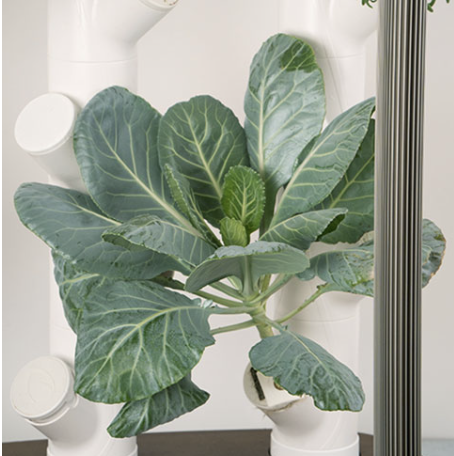Collard Greens
Latin name: Brassica oleracea var. acephala
🌱 Days to Sprout: 5-10 days
😋 Ready for Full Dose of plant food with true leaves or roots .5-inch long
✂️ Thin to: 1 plant per yCube
🍅 Days to Maturity: 60-70 days
💡 Light Zone: Medium
📏 Plant Size: < 2 ft
💚 Care Level: Beginner
Origin
Collard Greens, among the oldest varieties in the cabbage family, date back to prehistoric times. Originating in the Eastern Mediterranean, they played a role in Greek, Roman, and Asian cuisine before arriving in America with the first Africans in the early 1600s.
Qualities
Collard Greens are a non-head-forming cabbage akin to kale. The plant boasts broad, paddle-shaped leaves in shades of grey to deep green adorned with contrasting white ribs and veins. Their assertive, slightly bitter flavor is complemented by a chewy texture, making them a distinctive and flavorful addition to dishes. Collard Greens are one of the most nutrient-dense leafy green options, packed with omega-3 fatty acids, antioxidants, detoxifying glucosinolates, and vitamins K, C, and E.
Use
Collard Greens are ideal for slow cooking, releasing nutrients into the rich broth known as pot liquor or 'potlikker.' Quick braising or blanching ensures maximum flavor with full nutritional retention. Additionally, young leaves make a tasty addition to salad blends.
Care & Harvest
💡Temperature: Prefers cooler temperatures (55-75°F), but can still produce in warmer temperatures.
✂️ Pruning: Check the roots monthly and trim any that are brown or extending past the yPod. Snip any yellow or brown leaves if they appear. To delay bolting, cut yellow-flowering stems as they appear.
🔎 Plant Health: Collard leaves have a waxy, glossy coat that is a natural protector from pests, but it's always best to practice our prevention tricks!
🥬 Harvest: For ongoing harvest, snip the lower leaves just above the stem of the plant and let the upper leaves continue to grow. Don't cut more than 1/3 of the plant if you want it to keep growing. For a one-time harvest instead, wait for the plant to reach maturity, then snip at the stem’s base and harvest individual leaves off the stem.
Our Plant Health & Nutrition Team thoroughly tests each variety we offer to bring you the most flavorful and high-quality plants. We regularly rotate our plant portfolio, so please note, availability varies.

